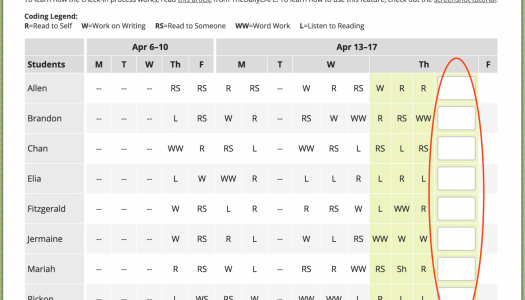Smooth Check-In
Checking in occurs when students choose their Daily 5 activity and teachers record the choices. When explicitly taught and practiced, the check-in process can be accomplished quickly and efficiently in less than two minutes. Here’s how.
When the brief focus lesson is complete, and before each round of Daily 5 (whether we do two, three, or four rounds), students verbally check in and we record their choice on the check-in sheet. Students are asked to be ready with their first and second choices. Having both ready helps keep things moving if their first choice is full. (We limit Read to Someone to six partners/three partnerships. Other activities, such as Listen to Reading, are limited based on available supplies.) Gail elects two students to keep track of how many children have chosen Read to Someone and Listen to Reading. It is their responsibility to share when these selections are full so students will know to check in with their second choice. Instead of having students keep track, I hold fingers up for each Read to Someone choice and let them know when we get to six and it is full. If we end up with an uneven number for Read to Someone, we say, "We have three for Read to Someone. Would one of you like to opt out or would someone like to hop in?” Someone almost always volunteers to do one of those two. Since I only have room for three students to choose Listen to Reading, I can easily keep track of that on my own as we check in.
When they are first learning to check in, we call a student name and they tell us where they would like to go for the round. Using a simple code, we record the choice on the form: R for Read to Self, RS for Read to Someone, W for Work on Writing, WW for Word Work, and L for Listen to Reading. We always go in order, but we vary which child’s name we begin with to ensure that the same children don’t always get to choose first. The consistency of the order helps students be ready, knowing they will always come after a certain classmate. Starting in different places ensures that everyone gets a chance to choose in the beginning.
Since we want this process to go quickly, we don’t give them very much wait time. If a student has not provided a choice after two seconds, we kindly say, “I will come back to you” and move to the next name on the list. This accomplishes a few things. It maintains the attitude that our practice time is important and we can’t waste time getting there. Students who need more time to think get that time. They also learn that if they aren’t ready, some of the options won’t be available when they are, so they are more careful to be ready in the future. It also removes the power of students who dawdle just to get attention.
This verbal agreement acts as a contract, which motivates students to get started right away and follow through on the task. It also helps to build a sense of community in which it’s understood that everyone, no matter what their skills and talents, is working to grow in one area or another. After students have mastered the basic check-in process, and after our assessments are complete, we add goals and strategies to the procedure.
It sounds something like this:
Me: Jacob?
Jacob: I am going to Read to Self. My goal is to expand my vocabulary, and I am going to tune in to interesting words.Me: Simranpreet?
Simranpreet: I am going to Work on Writing. My goal is to improve my content. My strategy is to add more details.Me: Sahil?
Sahil: I would like to Read to Someone. My goal is fluency. My strategy is to pay attention to punctuation.
My clipboard holds enough columns for a week of choices. This ability to view the week at a glance helps me know if I need to nudge a student toward a choice that will help them reach their goals.
Choice is one of the foundational elements of Daily 5. It is because of choice that student engagement, ownership, and stamina is so high in our classrooms. This check-in process provides choice, maintains a high level of accountability, and enables us to easily keep track of it all.







